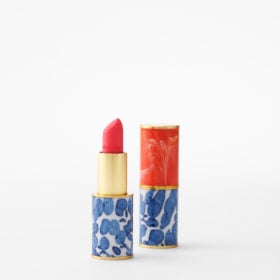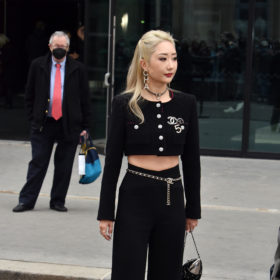
May 17, 2021 at 06:30PM
“Solar energy activist” and “supermodel” aren’t the commonest of paired titles. But that’s the magic of Grace Mahary. Thwarting expectations, she says, is kind of her thing. In the midst of a flourishing career — her client roster includes fashion’s heaviest hitters, such as Chanel, Givenchy and Balmain, and she was recently one of the stars of Mejuri’s Golden Together campaign (for a collection that has a philanthropic angle, naturally) — the Edmonton native founded Project Tsehigh, an organization that provides developing communities with clean-energy solutions. “I don’t know what a renewable energy non-profit founder is supposed to look like, but I don’t care,” she says. “That’s just how I lead.”
Mahary’s motivation to effect change came after travelling from the Paris couture shows in 2012 to her parents’ home country of Eritrea, where 70 per cent of the population is completely off the electrical grid. The now L.A.-based model witnessed the negative consequences of this circumstance first-hand: diminished study hours for schoolchildren, community-spread disease caused by evening animal bites, and the plumes of toxic black exhaust that would fill the homes of those fortunate enough to own a backup generator. Her bright solution? Introducing solar panels—a sustainable alternative with the potential for big impact. After a successful first implementation in Eritrea following fundraising initiatives and the creation of a donor base, Project Tsehigh (meaning “sun” in Tigrinya, the language spoken in her ancestral country) has since gone on to outfit a primary school in Tanzania with solar-powered accessories while equipping locals with the tools and resources to maintain the new infrastructure for years to come.
Engaging the bevy of high-profile contacts accrued during her modelling gigs and using her platform, which includes a hearty 140,000+ Instagram followers, to bring about real good was a no-brainer for Mahary. “It’s hard to separate human justice from what you do for a living,” she says. “There was something inside of me that always wanted to even out the playing field.” Here, Mahary shares her biggest learnings leading a non-profit and how you, too, can make a meaningful difference in the sustainability space.
Find your “why” and then constantly revisit it
Experiencing Eritrea’s energy poverty herself was the wake-up call that Mahary needed to make the leap into sustainability. Discovering your raison d’être, she says, doesn’t mean you have to pledge to support one cause forever or strive to be an activist. Even Mahary admits that she has trouble with that philanthropic label. “What I do is what I want to do,” she says. “It’s not because I’m an activist per se; it’s that this is what I feel we should be doing anyway.” In that sense, she looks at giving back as a long-term investment — a commitment to constant self evaluation: “You will always be checking in with yourself about how you’re contributing to the world and to others.”
View this post on Instagram
ADVERTISEMENT
ADVERTISEMENTKate Spade Autumn/Winter Sale |
Do your research (and do it often)
With no institutionally recognized credentials to her name, Mahary knew her lack of experience in the non-profit world would raise eyebrows. “As a Black woman and model, I realized that no matter what I do, I’ll always be undermined by some people,” she says. To ward off imposter syndrome — a psychological blight that, Mahary admits, still crops up from time to time — she equipped herself with enough knowledge and skills that she couldn’t be questioned. At the start of her undertaking, Mahary turned to free resources and grant opportunities that explained the ins and outs of non-profit life, like proposal writing, management and transparency. Building a tight-knit team around her who could fill in the gaps helped, too. Being an effective leader, she says, is recognizing that you can’t be an authority on every piece of the puzzle. “Everyone on the Project Tsehigh team isn’t an expert in everything — nobody is,” says Mahary. “But everyone has a strength, and they come in and share what they can. I find it really humbling, actually.”
Follow those who are already doing the work
See an inequity; sow your own solution — seems like a surefire formula, right? While it may be tempting to launch a do-good endeavour — an all-too-common reaction in our entrepreneurialism-fixated culture — Mahary says it’s critical to first offer your skills and assistance to the pioneers who are already on the ground. “Ask how you can help them and what they might need from you,” she suggests. “The issue right now is that some are asking the people who are doing the work to do more work — to teach them how to do it.” Exhausting those already burdened resources, especially those who are BIPOC-identifying, only impedes progress. Get yourself up to speed by fundraising, volunteering, asking questions and really listening. “Being more selfless — that’s how you learn what it’s like to be in those positions,” she adds.
Always be willing to pivot your plan
When the pandemic grounded Project Tsehigh’s mission to bring a third solar energy instalment to East Africa, Mahary didn’t slow down her give-back efforts. Instead, she zeroed in on the racial injustices in North America and teamed up with two established organizations, Grouphug and Trap Garden, to deliver community-based gardening boxes and window solar panels to BIPOC neighbourhoods in the U.S. facing food insecurity. Wielding this kind of flexibility is key in the non-profit sector, she says, where the best-laid plans — and most virtuous of intentions — can quickly go awry. “When you go into these communities, you want to serve them in one way, but they might ask for another thing,” she explains. It’s why Mahary has employed a no-ego policy to her non-profit’s mission: Find the most ideal solutions and know what true success looks like, despite your early definitions.
The post Model Grace Mahary On Navigating the Evolving Nature of Activism appeared first on FASHION Magazine.
Read More Fashion News
Author Jillian Vieira | Fashion Magazine
Selected by CWC
ADVERTISEMENT
ADVERTISEMENTUp to 30% off Gift Sets |






